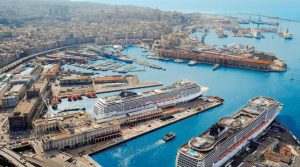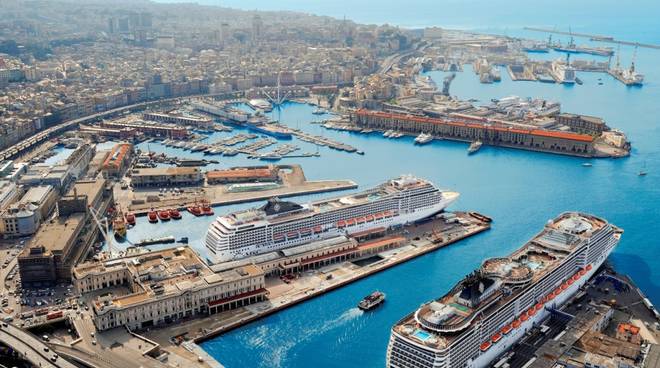The Port of Genoa, known as Porto di Genova in Italian, stands as a monumental gateway to the Mediterranean Sea. With deep historical roots that trace back to around 1000 AD, it is a cornerstone of Italian maritime commerce, contributing significantly to the local and national economy through its expansive trade operations. Positioned at 44.4028°N latitude and 8.91667°E longitude, the Port of Genoa is Italy’s busiest port by cargo tonnage, second only to the port of Trieste. As of the latest reports, it boasts a trade volume exceeding 51 million tonnes, reflecting its pivotal role in global maritime trade. The lighthouse of Genoa, Lanterna, a towering beacon of 76 meters, stands guard over the old Sampierdarena quarter, a testament to the port’s longstanding maritime legacy. The port also garnered international attention for dismantling the Costa Concordia, which tragically capsized in 2012.
Structural Characteristics: Spanning a vast 700 hectares of land and 500 hectares of water, the Port of Genoa stretches over 22 kilometres of the Ligurian coastline. It comprises:
Port Entrances: The port has four principal access points:
- Eastern inlet, leading to the historic port, shipyards, and Sampierdarena terminals.
- Western (Cornigliano) inlet, primarily for vessels heading to ILVA quays.
- Multedo entrance, the pathway for oil terminals and Fincantieri shipyards.
- Pra’ entrance, dedicated to the container terminal at the port’s western extremity.
Passenger Terminals: The passenger terminals sprawl over 250,000 square meters, equipped with:
- 5 berths for cruise ships
- 13 for ferries
- Annual handling capacity for 4 million ferry passengers, 1.5 million vehicles, and 250,000 trucks.
The Ponte dei Mille terminal stands out as a state-of-the-art cruise terminal, boasting airport-like efficiency for passenger embarkation and disembarkation. Furthermore, a new cruise terminal is under construction at the reimagined Ponte Parodi, enhancing the port’s capacity to accommodate the growing cruise industry.
Lighthouses and Safety:In addition to Lanterna, the small lighthouse at Punta Vagno marks the eastern entrance, both playing crucial roles in navigation and safety within the port’s expanse.
Marinas and Leisure: The port’s versatile functionality also encompasses leisure, with several marinas that accommodate yachts and sailboats:
- Exhibition centre marina: 305 berths
- Marina Duca degli Abruzzi (Yacht Club Italiano): 350 berths
- Marina Molo Vecchio: 160 berths for large yachts
- Marina Porto Antico: 280 berths
- Marina Genova Aeroporto: 500 berths with superyacht facilities
- Marina of Pra’: 1000 berths in the restored “Fascia di Rispetto di Pra'” beach area.
Regulatory Compliance and Environmental Considerations
In line with international regulations, the port maintains stringent controls over its operations. It complies with the International Ship and Port Facility Security (ISPS) Code and is certified under the International Oil Pollution Prevention (IOPP) certificate. This commitment ensures adherence to environmental standards, notably highlighted by the dedicated facilities for sludge and bilge water treatment and the use of shore power to minimize emissions.

The Port Authority of Genoa, through the Port Environmental Energy Plan (PEAP), has initiated to take concrete energy-saving actions by rationalizing consumption and generating energy from renewable sources.
For example, the already implemented actions consist in providing shore power to vessels while hosted at ship-repairs facilities and planning energy saving measures by adopting renewable sources.
An accurate monitoring of consumption has been envisaged to create an accurate database to be used as a reference guide aimed to optimize energy efficiency. It has also been foreseen the progressive replacement of fossil fuels with alternative renewable sources (biomass fuels, LNG), in order to reduce CO2 emissions in port areas and improve air quality.
From this perspective, therefore, the Harbour Masters office is monitoring vessels’ emissions in collaboration with ARPAL.
An analyses of the Port Authority’s of Genoa buildings has been scheduled to provide energy certificates and undertake restructuring works targeting energy efficiency.
The different technologies currently evaluated by PEAP (requalification of buildings, solar and photovoltaic thermal panels, biomass use, wind power, geothermal energy) have close relation with the commitment of concessionaires implemented by undertaking an “Energy Diagnosis” of buildings and consumptions to outline the most suitable actions.
Furthermore, public lighting is being upgraded by replacing traditional lamps with low energy lights (LED). In order to set the bar for the Green Port economy, the policy we have been adopting shall gradually replace our cars-fleet with electric vehicles while also embedding fast-charging stations in strategic sites within the port area.
The document is being continuously updated , in accordance with the National and European regulatory framework agreement, and targets merging , by developing synergies, port concessionaires activities with the new initiatives promoted by the Port Authority.


Very good, thank you for this detailed information
thank you